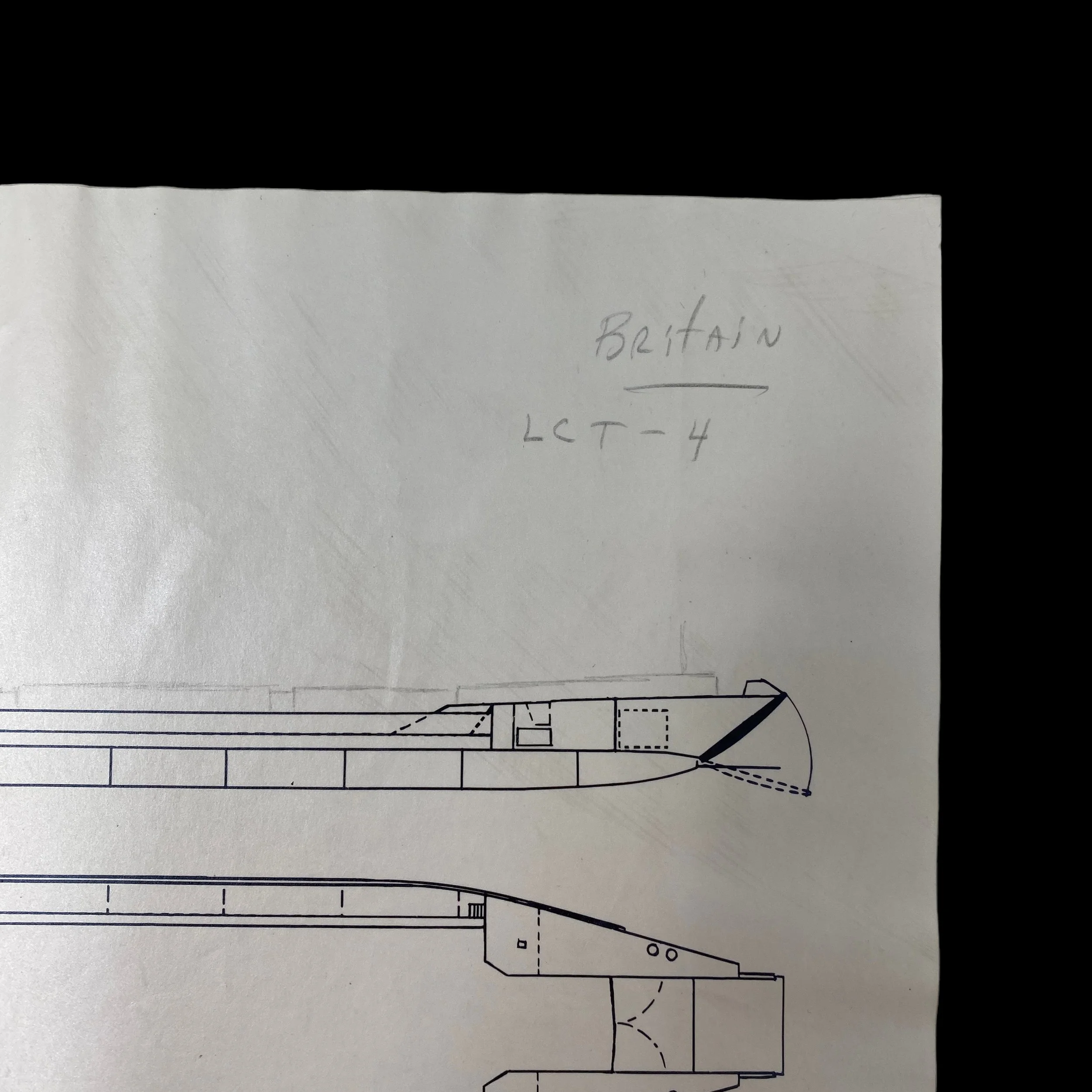RARE! Original WWII Normandy D-Day British Landing Craft Tank Mark IV Blueprint




















RARE! Original WWII Normandy D-Day British Landing Craft Tank Mark IV Blueprint
Comes with hand-signed C.O.A. and a full historical write-up
This incredibly rare and museum-grade original WWII Landing Craft Tank Mark IV blueprint diagram was used during the design, constriction, and repair of the Landing Craft Tank Mark IV during World War II. This rare working blueprint features many hand-marking and revisions that were done during the initial design process.
The LCT Mark 4 played a significant role in numerous Allied operations during World War II. It was an integral part of amphibious assaults in various theaters, including the North African campaign, the Mediterranean, the Pacific, and, most notably, the D-Day landings in Normandy. In these operations, the LCT Mark 4 acted as a vital link between the larger naval vessels and the shore, enabling the swift and efficient movement of tanks and troops directly to the battlefront. One of the most iconic uses of the LCT Mark 4 was during Operation Overlord, the Allied invasion of Normandy on June 6, 1944. The craft played a pivotal role in landing Allied forces on the beaches of Utah, Omaha, Gold, Juno, and Sword. Their ability to carry heavy armor like Churchill tanks directly to the beaches was instrumental in securing the foothold required for the successful liberation of Western Europe.
During World War II, the success of amphibious operations played a pivotal role in the Allied strategy to liberate Europe from German occupation. Among the many specialized landing craft used by the British Royal Navy, the Landing Craft Tank Mark 4 (LCT Mark 4) emerged as a vital component for the successful execution of amphibious assaults.
The LCT Mark 4 was developed as part of a series of landing craft introduced by the British Royal Navy in the 1930s, driven by the need to create specialized vessels for amphibious warfare. The threat of German expansion in Europe, particularly in the early stages of World War II, emphasized the importance of having a capable and adaptable landing craft to support the eventual Allied invasion of mainland Europe. The LCT Mark 4 was a direct response to this need and was designed to transport tanks, vehicles, and troops from naval vessels to enemy-held shores.
The LCT Mark 4 had a distinctive design that made it well-suited for its role in amphibious operations. The craft was 192 feet long, 30 feet wide, and had a shallow draft, enabling it to navigate shallow waters close to the shore. The craft had a bow ramp that could be lowered to allow vehicles and troops to disembark rapidly. This innovative design made it one of the most effective landing craft of its time. Its capacity to transport up to 10 Churchill tanks, or a combination of tanks and other vehicles, along with hundreds of troops, made it a vital asset for large-scale amphibious landings.
The LCT Mark 4 had a crew of 12 to 16 sailors, including a commander, navigators, and engineers. It was powered by twin diesel engines, which provided the necessary propulsion to maneuver in landing zones, whether on the beaches of Normandy, the coast of North Africa, or the islands of the Pacific. The craft's shallow draft was particularly important, as it allowed it to beach on shallow shores, unloading its cargo with ease.
The LCT Mark 4 played a significant role in numerous Allied operations during World War II. It was an integral part of amphibious assaults in various theaters, including the North African campaign, the Mediterranean, the Pacific, and, most notably, the D-Day landings in Normandy. In these operations, the LCT Mark 4 acted as a vital link between the larger naval vessels and the shore, enabling the swift and efficient movement of tanks and troops directly to the battlefront.
One of the most iconic uses of the LCT Mark 4 was during Operation Overlord, the Allied invasion of Normandy on June 6, 1944. The craft played a pivotal role in landing Allied forces on the beaches of Utah, Omaha, Gold, Juno, and Sword. Their ability to carry heavy armor like Churchill tanks directly to the beaches was instrumental in securing the foothold required for the successful liberation of Western Europe.
The LCT Mark 4's significance in World War II cannot be overstated. This landing craft was an essential component of the Allied war effort in multiple theaters, facilitating the capture of strategically important locations and the liberation of occupied territories. Its role extended beyond the D-Day landings, as it was used in subsequent operations in the Mediterranean, the Pacific, and other theaters of war.
The craft's adaptability was a key asset. It was designed to handle various types of cargo, including not only tanks and vehicles but also troops and supplies. This versatility allowed the Allied forces to quickly respond to changing tactical situations, reinforcing the front lines and providing much-needed logistical support.
The British LCT Mark 4 stands as a testament to the importance of specialized equipment in military operations. Its design and deployment during World War II were pivotal in the success of numerous Allied amphibious operations, ultimately contributing to the defeat of the Axis powers and the liberation of occupied territories.
The LCT Mark 4's shallow draft, cargo capacity, and versatility made it a key asset in the Allied arsenal. Its role in the D-Day landings, along with its contributions in various other theaters of war, underscores its importance in shaping the course of World War II. The legacy of this landing craft lives on as a symbol of the innovation and determination of the Allied forces during one of the most significant conflicts in history.